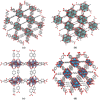Recent Advances in Nanoscale Metal-Organic Frameworks Towards Cancer Cell Cytotoxicity: An Overview
- PMID: 33994899
- PMCID: PMC8114195
- DOI: 10.1007/s10904-021-02011-3
Recent Advances in Nanoscale Metal-Organic Frameworks Towards Cancer Cell Cytotoxicity: An Overview
Abstract
Abstract: The fight against cancer has always been a prevalent research topic. Nanomaterials have the ability to directly penetrate cancer cells and potentially achieve minimally invasive, precise and efficient tumor annihilation. As such, nanoscale metal organic frameworks (nMOFs) are becoming increasingly attractive as potential therapeutic agents in the medical field due to their high structural variability, good biocompatibility, ease of surface functionalization as well as their porous morphologies with tunable cavity sizes. This overview addresses five different common strategies used to find cancer therapies, while summarizing the recent progress in using nMOFs as cytotoxic cancer cell agents largely through in vitro studies, although some in vivo investigations have also been reported. Chemo and targeted therapies rely on drug encapsulation and delivery inside the cell, whereas photothermal and photodynamic therapies depend on photosensitizers. Concurrently, immunotherapy actively induces the body to destroy the tumor by activating an immune response. By choosing the appropriate metal center, ligands and surface functionalization, nMOFs can be utilized in all five types of therapies. In the last section, the future prospects and challenges of nMOFs with respect to the various therapies will be presented and discussed.
© The Author(s), under exclusive licence to Springer Science+Business Media, LLC, part of Springer Nature 2021.
Conflict of interest statement
Conflict of interestThe authors declare no competing financial interest.
Figures




























Similar articles
-
Nanoscale Metal-Organic Frameworks for Cancer Immunotherapy.Acc Chem Res. 2020 Sep 15;53(9):1739-1748. doi: 10.1021/acs.accounts.0c00313. Epub 2020 Aug 18. Acc Chem Res. 2020. PMID: 32808760 Free PMC article.
-
Nanoscale metal-organic frameworks as photosensitizers and nanocarriers in photodynamic therapy.Front Chem. 2022 Aug 26;10:971747. doi: 10.3389/fchem.2022.971747. eCollection 2022. Front Chem. 2022. PMID: 36092660 Free PMC article. Review.
-
Versatile Nanoscale Metal-Organic Frameworks (nMOFs): An Emerging 3D Nanoplatform for Drug Delivery and Therapeutic Applications.Small. 2021 Feb;17(8):e2005064. doi: 10.1002/smll.202005064. Epub 2021 Jan 28. Small. 2021. PMID: 33511778 Review.
-
Hollow/porous nanostructures derived from nanoscale metal-organic frameworks towards high performance anodes for lithium-ion batteries.Nanoscale. 2014;6(3):1236-57. doi: 10.1039/c3nr05192g. Nanoscale. 2014. PMID: 24356788
-
Nanomedicines based on nanoscale metal-organic frameworks for cancer immunotherapy.Acta Pharmacol Sin. 2020 Jul;41(7):928-935. doi: 10.1038/s41401-020-0414-6. Epub 2020 Apr 30. Acta Pharmacol Sin. 2020. PMID: 32355277 Free PMC article. Review.
Cited by
-
Solvent-Free Process for Preparing Metal-Organic Framework Composites Based on Carbon-Based Quantum Dots and Their Derivatives as Drug Delivery Systems for Andrographolide.Chemistry. 2025 Jun 17;31(34):e202500655. doi: 10.1002/chem.202500655. Epub 2025 May 12. Chemistry. 2025. PMID: 40326208 Free PMC article.
-
Recent advances in porous nanomaterials-based drug delivery systems for cancer immunotherapy.J Nanobiotechnology. 2022 Jun 14;20(1):277. doi: 10.1186/s12951-022-01489-4. J Nanobiotechnology. 2022. PMID: 35701847 Free PMC article. Review.
-
A Zeolitic Imidazolate Framework-Based Antimicrobial Peptide Delivery System with Enhanced Anticancer Activity and Low Systemic Toxicity.Pharmaceutics. 2024 Dec 13;16(12):1591. doi: 10.3390/pharmaceutics16121591. Pharmaceutics. 2024. PMID: 39771569 Free PMC article.
References
-
- M.G. Krukemeyer, V. Krenn, F. Huebner, W. Wagner, R. Resch, J. Nanomed. Nanotechnol. 06, 336 (2015).
Publication types
LinkOut - more resources
Full Text Sources
Other Literature Sources
Research Materials
